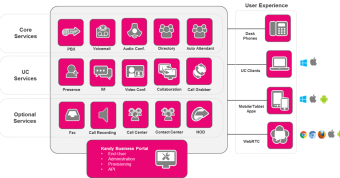Go Green, Save Green, Make Green: Practical Approaches to Transforming the Public Network
The public switched telephone network (PSTN), is arguably the largest legacy network in the world. While the Internet has grown, and a significant portion of voice calls today travel over the Internet, the importance of the PSTN is still very real and there remains a need to connect people with the quality voice services they’ve come to rely on. In fact, more than one billion people globally and the majority of all businesses still rely on the PSTN.

Given advances in IP technology and applications, we no longer need the PSTN in its current state, but do need a transformed “public network” – one that will provide what consumers and businesses are accustomed to receiving now, while also providing the features and services that come with IP-based technology. And, an IP-based network that ensures the same quality, reliability and ubiquity that the PSTN has afforded the world over the last 100 years.
This massive, global voice network is interconnected by switching centers, allowing any telephone in the world to communicate with any other. Originally a network of fixed analog lines, the PSTN is now almost 100% digitized in the core, and connects to mobile and other networks as well as supporting a declining number of fixed phones. The rapid decline of fixed lines has tapered off and is stabilizing in 2014, with businesses now accounting for a larger percentage of the remaining lines, relying on it for quality real-time communications.
Businesses, which are high-value customers to service providers and operators, continue to rely on dependable “phone systems” to function – but even they are advancing the adoption of IP solutions and software approaches, whether in contact centers or other high-volume transaction offices.
A $130 Billion Industry for “Voice” In the US Alone: Let’s Not Abandon It – Let’s Invest In It
Over the last twenty years, real-time communications has exploded and continues to grow. People are connecting with each other more than ever, with more modalities to choose from, including voice, instant messaging, SMS, over-the-top services like Skype, and more. Mobile and fixed experiences are blending, with the growth of hot spots and WiFi, while bundled services continue to fuel growth with triple and quadruple plays.
How can the different tier carriers in the US and the competitive carriers, finally make the move to support the future IP network while gracefully unwinding the world’s largest legacy utility – with no interruption of essential services?
Invest to Compete: Leverage Your Customer Footprint While You Can
All of us in the industry, which I’ve been part of for nearly three decades, witnessed the profound disruption VoIP brought, as IP networks grew to become the primary mode for voice calls. Companies like Google and Skype came out of nowhere to grow from zero to billions of dollars in market cap in a matter of years. Most recently, a relatively small company named WhatsApp (a proprietary, cross-platform instant messaging subscription service for smartphones that uses the Internet for messaging, images, voice and video communication) was acquired by Facebook for $19 billion.
This is the value placed on real-time communications and connecting people.
Society needs to be able to communicate in real-time now more than ever. With advancements in software and real-time communications applications – we can enable this transformation, and the time to invest is now. Let’s all figure out a way to economically transform the high quality “public network” while also driving value for shareholders, and ensuring small towns and big cities and every neighborhood in-between is served.
Order of Magnitude – It’s A Big Market the Challengers Have Recognized
Google’s search business is arguably the best in the world and it’s a $60 billion business. Voice in the US alone is a $130 billion market and $300 billion worldwide. Why would anyone want to abandon this? Why not invest and build on this base?
Currently, US carriers are spending approximately $1.2 billion of capital expenditures a year to service a $130 billion industry. Is this the right level of investment to transform the PSTN – less than 1% of revenue?
Why not rethink the PSTN and migrate those essential networks to more modern technology? Why not fund this migration in part through savings from consolidation and by rolling out new and exciting services similar to those that companies like Skype, WhatsApp, fring, and other “over-the-top” alternatives have built and are creating billions of dollars in value from these same customers?
Isn’t there an opportunity given all the advancements in our industry to transform not just an aging “utility” but create a platform for real-time communications that will take us into the future?
There’s a huge upside opportunity to serve both consumers and businesses better that can impact the economy, building on a $130 billion market already in place.
It Gets Even Better: Operators Can Pay for the Modernization of the “Public Network” with Energy & Other Savings Alone
Costs are mounting against the aging infrastructure, which now causes nearly 60% of network failures – meaning we’re not really providing reliable service. In the US, more than 35,000 aging “central offices” power the PSTN, and these centers contain endless racks of old equipment and switches that burn through 12 billion kilowatt hours of power every year, which compares roughly to the power consumption of 1 million homes annually. CO2 emissions produced equal those of more than 2 million cars.
In the last decade, power costs have tripled, while IP technology has dramatically improved, and can be delivered on much smaller “form factors” than the massive, power hungry switches put in a decade or more ago.
The Bottom Line
Transforming the PSTN to IP can:
- Reduce energy costs 70%
- Reduce water usage 70%
- Reduce real estate requirements 85%
- Reduce CO2 emissions 40%

Not only that, IP paves the way for new services for the customers being served, with more reliability, more convenience, and more economic opportunity including in rural communities for whom voice has been the only service, and an increasingly expensive service compared to new options.
A Community Effort
Working with regulators, not only the FCC but also organizations like the DOE (US Department of Energy), and coordinating with banks and other sources of funding, we can create a mutually beneficial “calculus” that will help us cross the chasm to cleaner, leaner and more progressive real-time communications networks that will serve individuals, businesses and society. With the right creative thinking, economic approaches, efforts and actions, we can build a sustainable and powerful new “public network.”




